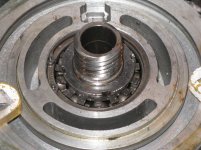mrtoes
Aluminum
- Joined
- Mar 15, 2014
- Location
- Amherst, NH
I am in the process of reconditioning a j head mill. I will be adding more questions to this thread as i go through the machine
To start with:
My table (9x36) had a good amount of surface rust on it, so i bought a large plastic tub and chelated it (molasses-water) for roughly three weeks. Today when i removed the table i was very disappointed with the result. Unfortunately i never took any pictures, but the molasses had seeped into the metal and turned the entire table brown. No matter how hard i tried, i could not remove the color. I went through just about every chemical known to man. Ontop of that, after 5 mins out of the tank the entire table flash rusted and butchered my already terrible looking surface finish. I know chelating (with molasses at a 9/1 ratio) is a tried and trued method for removing rust on large metal parts with bearing surfaces (Because it does not harm the metal under the rust). My question: Did i leave the table in long enough? What is the best way to clean the table after it is removed from the tank?
For anyone who has chelated their table/other components for a restoration, please give me all the details for what process you used. I have many other parts to do (knee, ram, saddle, etc) And would like to get it right next time.
Moving on
As soon as i removed the table from chelating, it became quite evident just how abused this machine was. There is not a single square inch of table surface that did not have a gouge or hole drilled in it. To a point that it looks almost intentional. The shop i bought the mill from apparently had no one trained to operate industrial machinery and therefore it took some abuse. I ran a fine grit stone over the top surface and found high points everywhere. The ways are in decent shape, but the table surface is trashed. I have decided to get the table ground (because i dont have the coin to get it scraped). Does anyone know a good shop to do the work in New England? And what cost am i looking at?
Lastly, I need to get my spindle bearings replaced. I have seen online that there is a shop (dont know who or where exactly) That replaces the original 2 open bearings with 4 sealed bearings. Is this a recommended upgrade? And how much more expensive is this versus the 2 original bearings.
I attached a few pics of when i first got the mill home
To start with:
My table (9x36) had a good amount of surface rust on it, so i bought a large plastic tub and chelated it (molasses-water) for roughly three weeks. Today when i removed the table i was very disappointed with the result. Unfortunately i never took any pictures, but the molasses had seeped into the metal and turned the entire table brown. No matter how hard i tried, i could not remove the color. I went through just about every chemical known to man. Ontop of that, after 5 mins out of the tank the entire table flash rusted and butchered my already terrible looking surface finish. I know chelating (with molasses at a 9/1 ratio) is a tried and trued method for removing rust on large metal parts with bearing surfaces (Because it does not harm the metal under the rust). My question: Did i leave the table in long enough? What is the best way to clean the table after it is removed from the tank?
For anyone who has chelated their table/other components for a restoration, please give me all the details for what process you used. I have many other parts to do (knee, ram, saddle, etc) And would like to get it right next time.
Moving on
As soon as i removed the table from chelating, it became quite evident just how abused this machine was. There is not a single square inch of table surface that did not have a gouge or hole drilled in it. To a point that it looks almost intentional. The shop i bought the mill from apparently had no one trained to operate industrial machinery and therefore it took some abuse. I ran a fine grit stone over the top surface and found high points everywhere. The ways are in decent shape, but the table surface is trashed. I have decided to get the table ground (because i dont have the coin to get it scraped). Does anyone know a good shop to do the work in New England? And what cost am i looking at?
Lastly, I need to get my spindle bearings replaced. I have seen online that there is a shop (dont know who or where exactly) That replaces the original 2 open bearings with 4 sealed bearings. Is this a recommended upgrade? And how much more expensive is this versus the 2 original bearings.
I attached a few pics of when i first got the mill home






